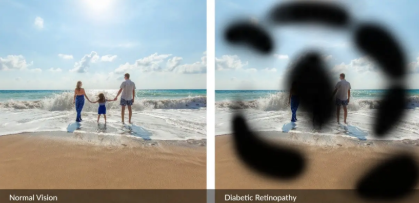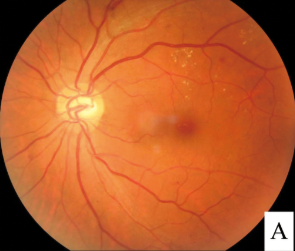By: Geraldus Sigap
For those living with diabetes, managing blood sugar levels is essential, but did you know that diabetes can also impact your eye health? Diabetes eye disease, or diabetic retinopathy, is a serious condition that can lead to vision loss if not properly managed. As diabetes becomes more common, so do related complications, and diabetic eye disease is one of the most concerning because of its potential to affect a person’s independence and quality of life. By understanding the risks, symptoms, and prevention methods associated with diabetes eye disease, you can take proactive steps to protect your vision for the future.

Diabetes eye disease, also known as diabetic retinopathy, occurs when high blood sugar levels damage the blood vessels in the retina, the light-sensitive layer at the back of the eye. The retina plays a crucial role in capturing images and sending them to the brain, and any damage to this area can lead to vision problems. Diabetic retinopathy is the most common cause of vision loss among people with diabetes and one of the leading causes of blindness in adults.
Diabetes eye disease develops gradually and progresses through different stages. In the early stages, blood vessels in the retina may weaken, causing small bulges and leaks, a condition known as non-proliferative retinopathy. If left untreated, the disease can progress to proliferative retinopathy, where new, fragile blood vessels grow on the retina’s surface, increasing the risk of bleeding and vision loss. Early diagnosis and treatment are essential to prevent these complications and maintain healthy vision.
High blood sugar levels are a primary cause of diabetes-related complications, including diabetic retinopathy. Over time, elevated blood sugar can damage blood vessels throughout the body, including those in the retina. This damage occurs because high blood sugar weakens the walls of blood vessels, making them more prone to leaks. When the blood vessels in the retina are compromised, they cannot deliver oxygen and nutrients effectively, leading to tissue damage and, ultimately, vision loss.
Additionally, high blood sugar can lead to swelling in the eye, which can further impact vision. The lens of the eye may swell, altering its shape and making it difficult for the eye to focus correctly. This can result in blurred vision, which may improve with blood sugar control but can worsen if blood sugar levels remain consistently high.
While diabetic retinopathy is primarily caused by high blood sugar, several other factors can increase the risk of developing this condition. These risk factors include:
- Duration of Diabetes: The longer a person has diabetes, the higher their risk of developing diabetic retinopathy. People who have lived with diabetes for many years are more likely to experience complications, especially if their blood sugar has not been consistently managed.
- Poor Blood Sugar Control: Individuals with poorly controlled diabetes are at a higher risk of developing eye problems. Consistently high blood sugar levels contribute to blood vessel damage and increase the risk of diabetic retinopathy.
- High Blood Pressure: High blood pressure can compound the effects of high blood sugar by placing additional strain on blood vessels, including those in the eyes. Managing blood pressure is essential for people with diabetes to reduce the risk of diabetic eye disease.
- High Cholesterol Levels: Elevated cholesterol can contribute to fatty deposits in the blood vessels, further impairing blood flow to the retina and increasing the likelihood of vision problems.
- Smoking: Smoking damages blood vessels and reduces circulation, which can worsen the effects of diabetic retinopathy. Smokers with diabetes are at a greater risk of developing severe eye complications.
One of the challenges with diabetes eye disease is that it often develops without noticeable symptoms in its early stages. This is why regular eye exams are essential for individuals with diabetes. However, as the disease progresses, symptoms may begin to appear. These symptoms can include:
- Blurred Vision: Blurred or distorted vision is a common symptom, often caused by swelling in the retina or changes in the lens due to high blood sugar levels.
- Dark Spots or Floaters: People with diabetic retinopathy may see dark spots or floaters, which are small shapes that float in their field of vision. These are caused by bleeding from damaged blood vessels in the retina.
- Difficulty Seeing at Night: Reduced night vision or trouble adjusting to dim light can be a symptom of diabetic eye disease, as the retina is responsible for processing light and darkness.
Vision Loss: In more advanced stages of diabetic retinopathy, individuals may experience a partial or complete loss of vision. This can occur suddenly if there is bleeding in the eye or gradually as the disease worsens.

Figure 1. Normal vision VS Diabetic retinopathy vision
If you experience any of these symptoms, it is important to consult an eye specialist promptly. Early detection and treatment can make a significant difference in preserving your vision.

Figure 2. Retinopathy eye
Preventing diabetic retinopathy is possible with the right approach to diabetes management and eye care. Here are some key steps to protect your eye health:
- Control Blood Sugar Levels: Keeping blood sugar within the target range is essential for reducing the risk of diabetic retinopathy. Work closely with your healthcare provider to create a personalized plan for blood sugar management, including diet, exercise, and medication if needed.
- Monitor Blood Pressure and Cholesterol: Managing blood pressure and cholesterol levels can help protect the blood vessels in your eyes. Regular check-ups with your doctor can ensure that these levels are in a healthy range, reducing the risk of complications.
- Regular Eye Exams: Routine eye exams are crucial for detecting diabetic retinopathy early. Experts recommend that individuals with diabetes have a comprehensive eye exam at least once a year, even if they do not have symptoms.
- Quit Smoking: Smoking increases the risk of diabetic retinopathy and other complications. Quitting smoking can improve circulation and reduce the risk of blood vessel damage, helping to preserve your eye health.
- Stay Physically Active: Regular physical activity can help control blood sugar levels, improve circulation, and promote overall well-being, all of which contribute to better eye health.
If diabetic retinopathy is detected, there are several treatment options available to help manage the condition and prevent further vision loss:
- Laser Therapy: In cases where new, abnormal blood vessels are forming in the retina, laser therapy can be used to seal off leaking blood vessels and reduce the risk of vision loss. Laser treatment is often effective in slowing the progression of diabetic retinopathy.
- Medications: Some medications can be injected into the eye to reduce inflammation and swelling in the retina. These medications help stabilize blood vessels and are often used to treat macular edema, a complication of diabetic retinopathy.
- Surgery: In more advanced cases, surgery may be necessary to remove blood or scar tissue from the eye. This procedure, known as a vitrectomy, can restore vision in some cases by removing obstructions in the retina.
At RS Abdi Waluyo, our internal medicine specialists are dedicated to providing comprehensive care for patients with diabetes and related complications, including diabetic retinopathy. Our team offers a full range of services, from diabetes management and regular monitoring to advanced treatments for diabetes-related eye conditions.
With state-of-the-art facilities and experienced medical professionals, RS Abdi Waluyo ensures that patients receive high-quality, personalized care. Our internal medicine team works closely with eye specialists to provide holistic support, helping individuals with diabetes protect their vision and maintain their overall health. Choosing RS Abdi Waluyo means choosing a healthcare partner committed to helping you manage diabetes effectively and prevent complications.
Resources
- How To Prevent Diabetic Retinopathy? | RetinaRisk [Homepage on the Internet]. [cited 2024 Nov 20];Available from: https://www.retinarisk.com/blog/how-to-prevent-diabetic-retinopathy/
- Diabetic retinopathy [Homepage on the Internet]. Wikipedia. 2024 [cited 2024 Nov 15];Available from: https://en.wikipedia.org/w/index.php?title=Diabetic_retinopathy&oldid=1254897729
- Shukla UV, Tripathy K. Diabetic Retinopathy [Homepage on the Internet]. In: StatPearls. Treasure Island (FL): StatPearls Publishing, 2024 [cited 2024 Nov 15]; Available from: http://www.ncbi.nlm.nih.gov/books/NBK560805/
- Wang W, Lo ACY. Diabetic Retinopathy: Pathophysiology and Treatments. Int J Mol Sci 2018;19(6):1816.
- Diabetic Retinopathy: Causes, Symptoms, Treatment [Homepage on the Internet]. Am. Acad. Ophthalmol. 2024 [cited 2024 Nov 15];Available from: https://www.aao.org/eye-health/diseases/what-is-diabetic-retinopathy
